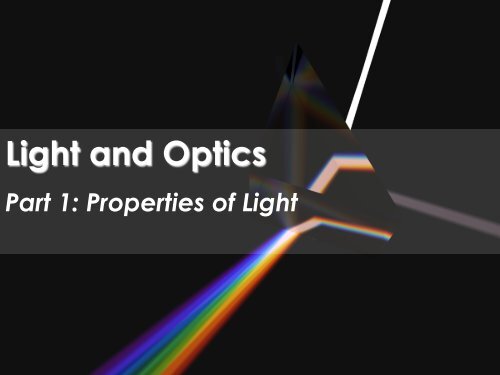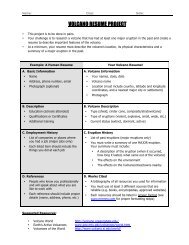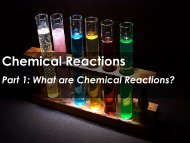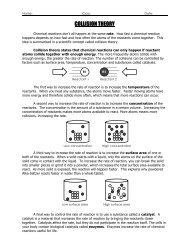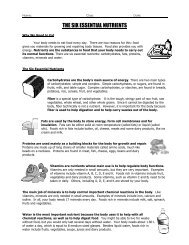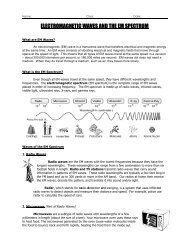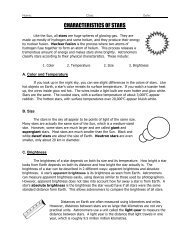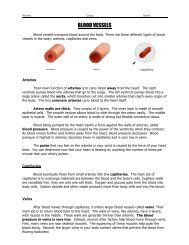Light and Optics - Science with Mr. Enns
Light and Optics - Science with Mr. Enns
Light and Optics - Science with Mr. Enns
You also want an ePaper? Increase the reach of your titles
YUMPU automatically turns print PDFs into web optimized ePapers that Google loves.
<strong>Light</strong> <strong>and</strong> <strong>Optics</strong><br />
Part 1: Properties of <strong>Light</strong>
Property 1<br />
<strong>Light</strong> is a form of energy.
Property 2<br />
<strong>Light</strong> exists as tiny particles called photons.
Property 3<br />
<strong>Light</strong> travels in straight lines called rays.<br />
Laser<br />
ray
Property 4<br />
Shadows are formed when light rays<br />
are blocked by an object.<br />
Rays of light<br />
Shadow
Property 5<br />
<strong>Light</strong> travels VERY fast: 300,000 km/s!<br />
This is equal to 670,616,629 mph!<br />
<strong>Light</strong> can<br />
travel<br />
around<br />
the Earth<br />
8 times in<br />
1 second!
Property 6<br />
<strong>Light</strong> travels much faster than sound.<br />
Sound travels only 5-7 km/s
Property 7<br />
A luminous object produces its own light.<br />
A non-luminous object only reflects light.
Property 8<br />
When light strikes an object, it can be:<br />
Reflected<br />
Transmitted<br />
Absorbed
Properties of <strong>Light</strong> – A Summary<br />
1) <strong>Light</strong> is a form of energy.<br />
2) <strong>Light</strong> exists as tiny particles called photons.<br />
3) <strong>Light</strong> travels in straight lines called rays.<br />
4) Shadows form when light rays are blocked.<br />
5) <strong>Light</strong> travels very fast (300,000 km/s)<br />
6) <strong>Light</strong> travels faster than sound (5-7 km/s)<br />
7) Luminous objects give off their own light. Nonluminous<br />
objects only reflect light.<br />
8) When light strikes an object, it can be reflected,<br />
transmitted or absorbed.
Any Questions
<strong>Light</strong> <strong>and</strong> <strong>Optics</strong><br />
Part 2: Reflection, Transmission <strong>and</strong> Absorption
Review<br />
When light strikes an object, 3 things can happen.<br />
The light can be:<br />
Reflected<br />
Transmitted<br />
Absorbed
Reflection<br />
We see objects because they reflect light into our eyes.
Types Reflection<br />
<strong>Light</strong> rays reflect differently off of different surfaces.<br />
Clear Reflection<br />
Smooth <strong>and</strong> shiny<br />
surfaces reflect light<br />
rays at the same angle<br />
e.g. mirrors
Types Reflection<br />
<strong>Light</strong> rays reflect differently off of different surfaces.<br />
Diffuse Reflection<br />
Rough <strong>and</strong> dull surfaces<br />
cause light rays to<br />
reflect at different angles<br />
e.g. carpet, wood…
Transmission<br />
Certain objects allow light rays to pass through.<br />
Transparent Objects<br />
Transmit nearly all of the light.
Transmission<br />
Certain objects allow light rays to pass through.<br />
Translucent Objects<br />
Transmit some of the light, but scatters it.
Transmission<br />
Certain objects allow light rays to pass through.<br />
Opaque Objects<br />
Do not transmit any light – they block it.
Absorption<br />
Absorption means to block light rays.<br />
Colored objects appear that way because they<br />
absorb some colors but reflect others.<br />
But first, we must learn<br />
about white light…
White <strong>Light</strong><br />
White light is not actually white!<br />
White light is made up of 7 different colors.<br />
We can show this by<br />
shining white light<br />
through a glass prism<br />
The prism splits the<br />
white light into its colors
White <strong>Light</strong><br />
The 7 colors in white light make up the spectrum.<br />
Remember: R O Y G. B I V !<br />
Red<br />
Orange<br />
Yellow<br />
Green<br />
Blue<br />
Indigo<br />
Violet
Adding Colors<br />
Colors of light can be combined to make new colors.<br />
The primary colors of light are red, blue & green.<br />
They can combine to produce ALL other colors.<br />
Adding blue <strong>and</strong> red<br />
makes magenta<br />
Adding blue <strong>and</strong><br />
green makes cyan<br />
Adding red <strong>and</strong><br />
green makes yellow<br />
Adding all 3<br />
colors makes white
Seeing Color<br />
Lets get back to colored objects…<br />
Different colored objects reflect their own<br />
color of light <strong>and</strong> absorb all the rest.<br />
Take this red shirt, for example:<br />
It The absorbs shirt looks all the red<br />
since other it colors reflects of red<br />
light the into spectrum our eyes
Seeing Color<br />
A white object reflects ALL seven colors:<br />
Appears<br />
white<br />
A purple object reflects violet, red & blue:<br />
Appears<br />
purple
Seeing Color<br />
If we looked at objects in colored light,<br />
we will see something different.<br />
Consider this red <strong>and</strong> blue outfit in white light:<br />
White light<br />
Shirt looks red<br />
Shorts look blue
Objects in Colored <strong>Light</strong><br />
But in different colored light, this outfit looks different:<br />
Red light<br />
Shirt looks red<br />
Shorts look black<br />
Shirt looks black<br />
Blue light<br />
Shorts look blue
Color Filters<br />
Color filters transmit certain colors <strong>and</strong> absorb the rest.<br />
White light<br />
Red light<br />
Red filter<br />
White light<br />
Magenta light<br />
Magenta filter
Any Questions
<strong>Light</strong> <strong>and</strong> <strong>Optics</strong><br />
Part 3: Mirrors <strong>and</strong> Lenses
Review<br />
When light strikes an object, 3 things can happen.<br />
The light can be:<br />
Reflected<br />
Transmitted<br />
Absorbed
Reflection Off A Plane Mirror<br />
<strong>Light</strong> reflects off a plane (flat) mirror in a certain way.<br />
Incident Ray Normal Reflected Ray<br />
Angle of<br />
incidence<br />
Angle of<br />
reflection<br />
Plane Mirror
The Law of Reflection<br />
The Law of Reflection states that for a plane mirror:<br />
Angle of Incidence = Angle of Reflection<br />
Incident Ray Normal Reflected Ray<br />
Angle of<br />
incidence<br />
Angle of<br />
incidence<br />
Plane Mirror
Images In A Plane Mirror<br />
<strong>Light</strong> rays reflect off a plane mirror in a regular way.<br />
Angle of Incidence = Angle of<br />
Reflection<br />
This makes the light rays seem to come from<br />
behind the mirror at an equal distance..<br />
This forms an image that is<br />
upright <strong>and</strong> the same size.<br />
It is a virtual image, since<br />
the light is not actually<br />
coming from the image.
Forming A Virtual Image<br />
Virtual Image<br />
Upright<br />
Same Size<br />
Reversed
Concave Mirrors<br />
Concave mirrors have surfaces that curve inward.<br />
A concave mirror reflects light rays so that<br />
they converge (meet) at a certain point.<br />
We call this point the<br />
focal point of the mirror.
Concave Mirrors<br />
Concave mirrors form images in 2 different ways.<br />
The type of image depends on the distance<br />
the object is placed from the focal point.<br />
Focal Point
1. Object is placed behind the focal point.<br />
Real Image<br />
Upside down<br />
Smaller<br />
2. Object is placed in front of the focal point.<br />
Virtual Image<br />
Upright<br />
Larger
Convex Mirrors<br />
Convex mirrors have surfaces that curves outward.<br />
A convex mirror reflects light rays<br />
so that they diverge (spread out).<br />
The light rays do NOT<br />
meet at a focal point<br />
in front of the mirror.
Convex Mirrors<br />
Convex mirrors ALWAYS form images the same way.<br />
A convex mirror forms a virtual image<br />
that is smaller than the true object.<br />
Focal Point
Refraction<br />
Refraction is when light rays are bent.<br />
When light rays pass from one material to<br />
another, the light rays refract (bend).<br />
The rays change direction<br />
where the 2 materials meet.<br />
The light bends because it<br />
changes speed in different<br />
materials (mediums).
Refraction<br />
Medium 1 - Air<br />
<strong>Light</strong> travels fast<br />
Medium 2 - Water<br />
<strong>Light</strong> travels slow
Index of Refraction<br />
Some mediums refract light rays more than others.<br />
This is described by the index of refraction.
Index of Refraction<br />
Indexes of Refraction for Common Materials<br />
Vacuum 1.00<br />
Air 1.01<br />
Water 1.33<br />
Glycerine 1.47<br />
Glass 1.52<br />
Diamond 2.42
Lenses<br />
A lens is a curved device that refracts light precisely.<br />
Lenses are useful because they can<br />
refract light rays in a predictable way.<br />
There are 2 types of lenses:<br />
Concave<br />
Convex
Concave Lens<br />
A concave lens is thinner in the middle.<br />
A concave lens bends parallel light<br />
rays to make them diverge.<br />
Produce a<br />
virtual image<br />
only
Convex Lens<br />
A convex lens is thicker in the middle.<br />
A convex lens bends parallel light rays<br />
so that they meet at a focal point.<br />
Produce a<br />
real or a<br />
virtual image
Lenses<br />
Lenses have many uses.
Any Questions
<strong>Light</strong> <strong>and</strong> <strong>Optics</strong><br />
Part 4: The Eye
Eye Anatomy<br />
cornea<br />
lens<br />
sclera<br />
retina<br />
fovea<br />
pupil<br />
iris<br />
optic nerve
Step 1<br />
<strong>Light</strong> rays pass through the clear cornea,<br />
which focuses them through the pupil.
The Pupil<br />
The size of the pupil can be changed.<br />
This is done by a ring of muscles called<br />
the iris, which surrounds the pupil.<br />
The color of the iris<br />
muscles vary, which<br />
gives people different<br />
eye colors.
Dim <strong>Light</strong><br />
Iris muscles contract<br />
Pupil opens - dilates<br />
Lets in more light<br />
Bright <strong>Light</strong><br />
Iris muscles relax<br />
Pupil constricts<br />
Lets in less light
SEM – Iris Muscles
Step 2<br />
<strong>Light</strong> passes through the lens, which further<br />
focuses the rays onto the retina.
The Lens<br />
The thickness of the lens can be changed.<br />
This lens can become thinner or thicker,<br />
depending on how far away an object is.<br />
This is done by<br />
ciliary muscles that pull<br />
the lens from above<br />
<strong>and</strong> from below.
Distant Objects<br />
Muscles contract<br />
Lens pulled thinner<br />
Focus shifts back<br />
Near Objects<br />
Muscles relax<br />
Lens made thicker<br />
Focus shifts forward
Step 3<br />
The focused light rays hit a layer of lightsensitive<br />
cells found on the retina.
The Retina<br />
The retina is a layer of cells at the<br />
back of the eye that can detect light.<br />
Specialized cells on the retina called<br />
rod <strong>and</strong> cone cells detect light.<br />
Rods <strong>and</strong> cones sense<br />
different things about the<br />
light that hits them.<br />
Rod Cell<br />
Cone Cell
Rods <strong>and</strong> Cones<br />
Cone Cells<br />
At the centre of the retina<br />
3 types: red, green & blue<br />
Detect color<br />
Rod Cells<br />
At the edges of the retina<br />
Only “see” black & white<br />
Detect brightness
The Fovea<br />
The fovea is a dip in the centre of the retina.<br />
Cone cells are concentrated in the fovea:<br />
most color vision occurs here.<br />
Cones concentrated at the fovea
The Fovea<br />
The fovea is a dip in the centre of the retina.<br />
Cone cells are concentrated in the fovea:<br />
most color vision occurs here.<br />
Rods found<br />
at the<br />
edges<br />
Cones concentrated at the fovea
From Eye To Brain<br />
Your brain “sees” differently than your eye.<br />
The optic nerve from the<br />
left eye connects to the<br />
right side of the brain,<br />
<strong>and</strong> vice versa.<br />
So, your brain sees<br />
everything reversed <strong>and</strong><br />
then switches it again!
Summary<br />
1. <strong>Light</strong> enters the eye through the cornea, a<br />
convex lens that focuses the light slightly.<br />
2. It passes through a hole called the pupil, which<br />
is controlled by a ring of muscles called the iris.<br />
3. The light passes through the convex lens,<br />
which focuses the light onto the retina.<br />
4. The retina is a layer of light-sensitive cells:<br />
cones for color vision <strong>and</strong> rods for brightness<br />
5. The rods <strong>and</strong> cones send electrical impulses<br />
to the brain along the optic nerve.<br />
6. The brain interprets the signals as visual images.
Any Questions
<strong>Light</strong> <strong>and</strong> <strong>Optics</strong><br />
Part 5: Correcting Vision
Sight Defects<br />
Sometimes, people’s vision is not perfect.<br />
When light does not fall directly on the<br />
retina, images will appear blurry.<br />
This can happen in 2<br />
major ways…<br />
Normal
Sight Defects<br />
Sometimes, people’s vision is not perfect.<br />
When light does not fall directly on the<br />
retina, images will appear blurry.<br />
The eye shape is<br />
not perfectly<br />
spherical.<br />
Long<br />
Short<br />
The lens muscles<br />
do not work<br />
This can<br />
properly.<br />
happen in 2<br />
major ways…<br />
Strong Weak
Nearsightedness<br />
Nearsightedness occurs when light<br />
is focused in front of the retina.<br />
They see well near, but not far.<br />
Causes:<br />
Eye shape is too long<br />
Lens made too thick<br />
Fixed <strong>with</strong> a concave lens.
Nearsightedness
Farsightedness<br />
Farsightedness occurs when light<br />
is focused behind the retina.<br />
They see well far, but not near.<br />
Causes:<br />
Eye shape is too short<br />
Lens made too thin<br />
Fixed <strong>with</strong> a convex lens.
Farsightedness
Cataracts<br />
Cataracts cause the lens to become cloudy.<br />
Cataracts are a genetic condition that run<br />
in families, especially African Americans.<br />
Cataracts cause a<br />
person to slowly lose<br />
their vision.<br />
Blindness can result.
Cataracts
Glaucoma<br />
High pressure in the eye causes glaucoma.<br />
Normally, fluid inside the eye is continually<br />
drained away by a drainage canal.<br />
eye fluid<br />
When this canal gets<br />
blocked, fluid builds up<br />
<strong>and</strong> pressure increases<br />
This pressure pushes on<br />
the lens, affecting vision
Glaucoma
Any Questions


